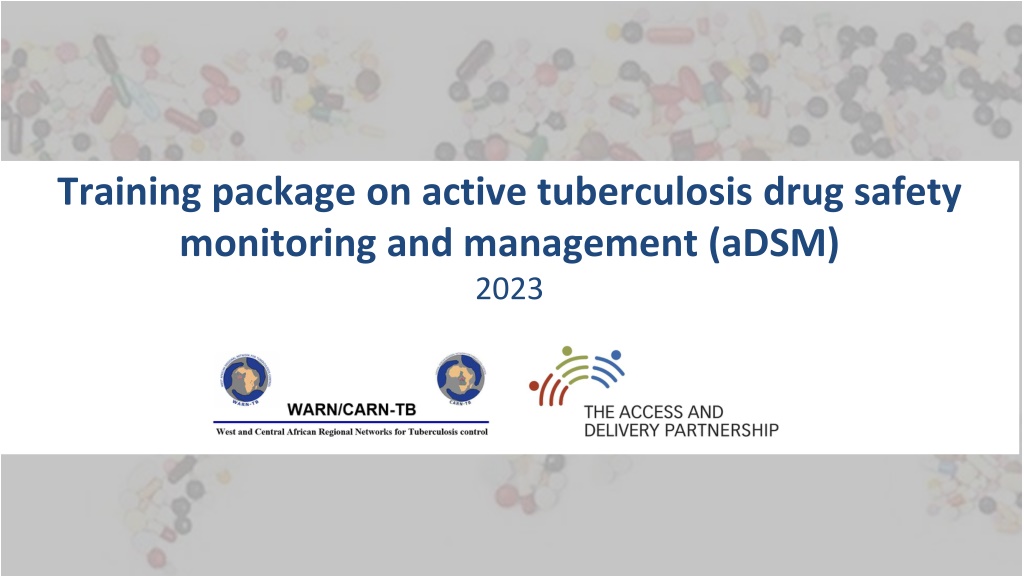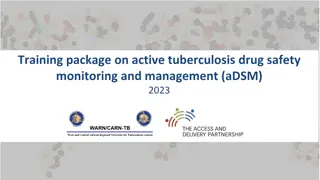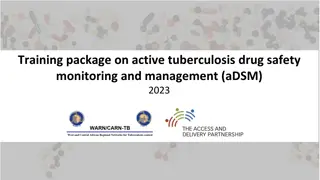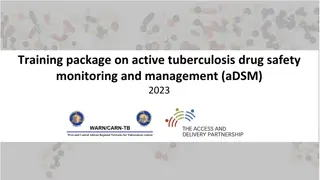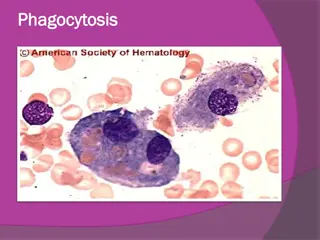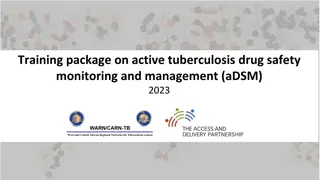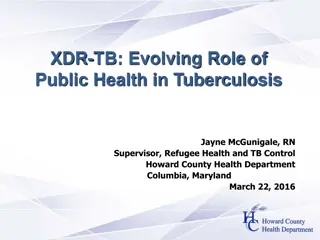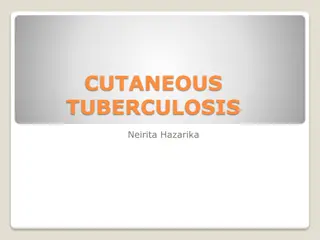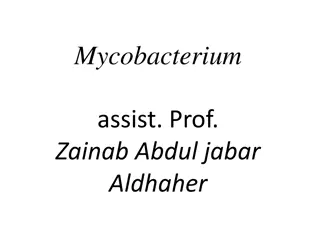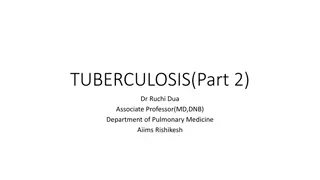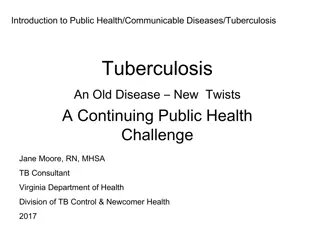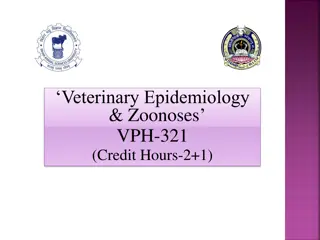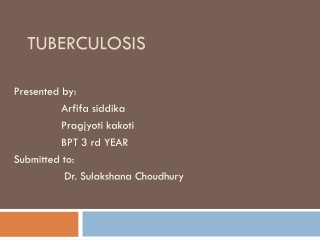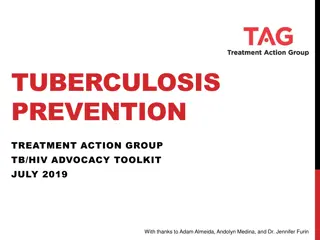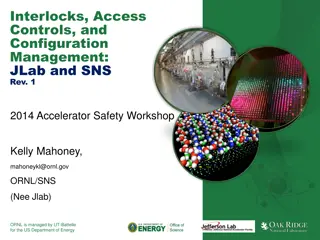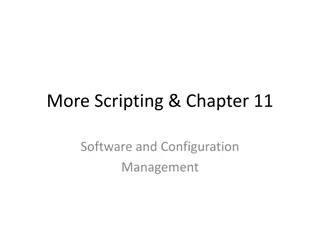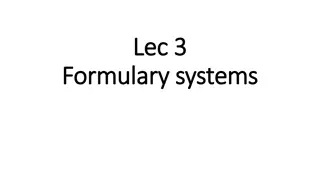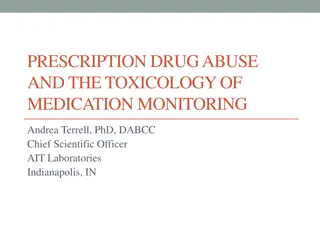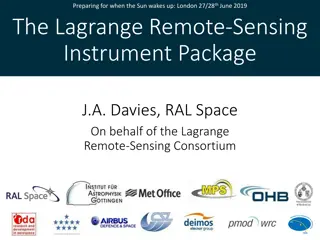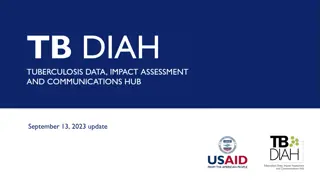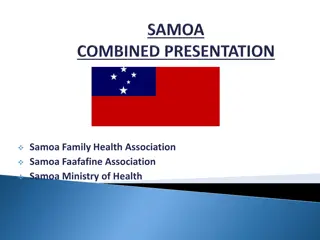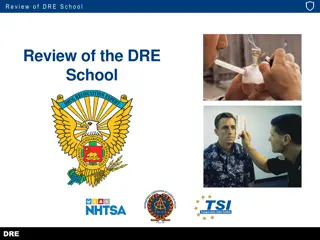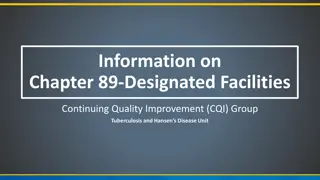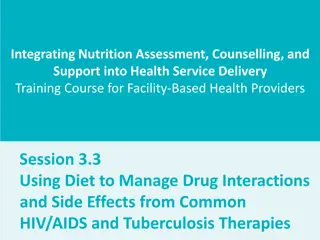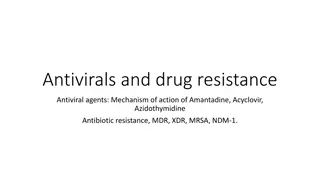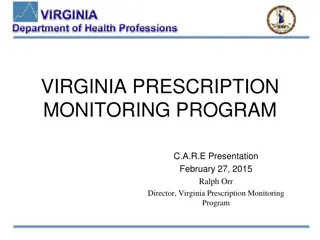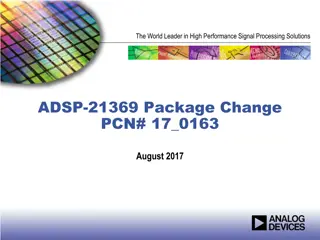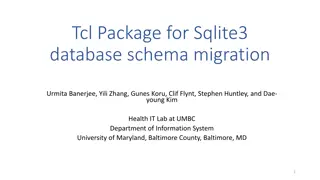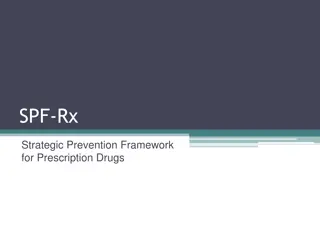Training Package on Active Tuberculosis Drug Safety Monitoring and Management (aDSM) 2023
This presentation focuses on organizing the training of key staff to collect data for active tuberculosis drug safety monitoring. It covers the proper use of standard forms and treatment cards to ensure systematic and efficient data collection, along with reporting procedures for adverse events. Participants will learn about alert reporting and the minimum information required for reporting AE/SAE. The goal is to improve data collection quality and promote patient safety in tuberculosis management.
Uploaded on Sep 23, 2024 | 0 Views
Download Presentation

Please find below an Image/Link to download the presentation.
The content on the website is provided AS IS for your information and personal use only. It may not be sold, licensed, or shared on other websites without obtaining consent from the author. Download presentation by click this link. If you encounter any issues during the download, it is possible that the publisher has removed the file from their server.
E N D
Presentation Transcript
Training package on active tuberculosis drug safety monitoring and management (aDSM) 2023
Learning objective By the end of this presentation, the participant is expected to be able to Organize training of key staff on the collection of aDSM data using the standard forms and treatment cards
Data collection Standard data collection forms Systematic Roles & responsibilities defined; staff trained Organized What do we want to see from these data? Result-oriented No duplicates ! Efficient
aDSM Report Forms alert, full report Treatment initiation AE or SAE Report Form Patient review Show the alert form for SAEs used at local level
SAE Alert reporting This specimen form includes the MINIMUM information to be collected for an alert
Some generalities when filling in an alert form The form should be sent promptly after the doctor (or other healthcare professional per National Regulation) learns about an adverse event (AE) or a serious AE (SAE). A written form is always needed Even if the Authority was alerted by phone, a written report should promptly follow. When reporting please use dd mmm yyyy format to report dates. 29th of June 2016 29 JUN 2016 Confidentiality must be ensured at all steps.
Minimum information for the alert report If all details are not available at the time of 1st knowledge of the AE or SAE, the reporter should send what is known promptly and then send a follow-up report with more details. Minimal 4 elements 1. Patient identifier, 2. Reporter identifier, 3. Drug s name or substance, 4. Basic information on AE/SAE. Example: TB patient (Lfx-Z-Cfz-Lzd-Bdq-Cs-PAS) died en route to another hospital. The patient s mother is calling you to tell you her son had chest pain and she had called ambulance. You don t have more information.
Completing the alert form (1) New vs. follow-up information Case reports evolve over time, every time you have new significant information, for example now the patient recovered, a new form will be sent with the new information only! No need to repeat fully initial info -> Just enter identifiers so that the recipient can identify which case is referred (patient s name, diagnosis, reporter s name)
Completing the alert form (2) Patient information
Completing the alert form (3) Suspected and concomitant drugs Enter the drugs you think are relevant to be evaluated for causal relationship with the event = SUSPECTED DRUGS CAUSING THE PROBLEMS; generally we advise to list all TB drugs ongoing at time of AE Enter the other drugs you think are not relevant but were taken at the same time as the suspected drugs =Concomitant Example: TB patient (Lfx-Z-Cfz-Lzd-Bdq-Cs-PAS) died from cardiac failure; he also takes Vitamin B6.
Completing the alert form (4) AE information (1/2) Event s onset and stop date: if the event is ongoing stop date can be left blank. Description: Provide diagnosis and explain what are the signs and symptoms. Provide the course of event, therapy, summarized investigation results (e.g. CT scan), few key lab values, etc. Can be used to mention elements you may not know where to enter (forms are never perfect!).
Completing the alert form (5) AE information (2/2) SERIOUSNESS CRITERIA 1. Fatal 2. Immediately life threatening 3. Leading to hospitalisation or prolongation of hospitalisation 4. Leading to a significant disability / incapacity 5. Birth defect or congenital anomaly Select as many as applicable! e.g. patient hospitalized due to acute renal failure then dies. 6. Otherwise medically important, necessitating an intervention to prevent one of the above listed outcomes
Completing the alert form (6) Action taken Did you stop a suspected drug? Lower the dose? Did not change anything? If one or more drugs have been initially stopped and then re-introduced and no further change is expected: Select Dose not changed. Explain in the description that you stopped and resumed the drugs. If only 1 drug was stopped: Select Medicine withdrawn. Explain in the description that Cs was stopped for example and the other drugs were maintained.
Completing the alert form (7) Outcome of event At the time of reporting, is the event Fully stabilized, back to baseline status Resolved Improving but still not back to baseline status Resolving Fully stabilized but some permanent condition will remain (e.g. hearing loss after permanent stop of injectable) Resolved with sequelae Still ongoing Not resolved Fatal Died Outcome is not known (e.g. patient lost to follow-up) Unknown
Completing the alert form (8) Reporter Easy to forget !
Completing the alert form (9) Further notes If >1 AE/SAE, which are distinct and unlinked (e.g., cardiac and neurological events) occur in the same individual, separate forms are completed and sent for each event Most of the times the information needed to complete the form is available in the patient s file, in the lab reports, in autopsy reports, etc. Usually, most systems allow you to append lab results or other docs directly to the form so that you don t need to re-write everything.
What happens once the aDSM forms reach the national coordination center? Upon receipt of the information the responsible authority will: Review the information, Contact the reporter and/or facility for more details Assist with causality assessment Perform signal detection and other statistical analyses, Decide on any action to protect public health (if applicable) Use the data to improve overall drug-safety and knowledge on drugs (e.g. by cross-reporting to WHO to inform further guidance).
Train others on the use of the forms Focus on the core requirements, here the 4 minimum criteria (patient, reporter, drug, SAE). Explain the terminology (e.g. suspected vs. concomitant drug) and each field of your form. Illustrate: use examples! Perform exercises with the doctors or other healthcare professionals that are expected to fill in the forms for the national aDSM. Case studies can be found in the presentation on AE monitoring and management.
Conclusions It is the responsibility of healthcare professionals to promptly inform the national aDSM coordination of SAEs (or other AEs, depending on the package in use) As soon as the 4 minimal elements are available, a form can be filled in and sent (depend on local regulations) Report forms are living documents and important follow-up information can be sent at any time after sending an initial report Staff need to be trained in the completion of the forms and feedback is helpful to ensure improved quality and completeness of reporting
Acknowledgements The development of the aDSM training material was funded by TDR as part of the Access and Delivery Partnership (ADP) with funding from the Government of Japan. These training materials were put together in 2016 the WHO Task Force on aDSM with technical partners KNCV Tuberculosis Foundation, Management Sciences for Health (SIAPS), MSF, WHO GTB, and TDR. The materials were updated in 2022-23 by Mahamadou Bassirou Souleymane (TDR consultant) with Marie-Eve Raguenaud (TDR), Branwen J Hennig (TDR), and Corinne Merle (TDR), and reviewed by Linh Nhat Nguyen (WHO/GTB), Medea Gegia (WHO/GTB), and Fuad Mirzayev (WHO/GTB). We thank all members of the WARN/CARN-TB working group on aDSM who contributed to the development of the aDSM generic guidelines as well as the secretariat, particularly Dr Christ Houessinon: Disadidi Ambrioso, Esse Marius, Adomou Jamal Rouamba Ruffine, Haro Sougrimani, Koumbem Boureima, Nsanzerugeze Jos lyne, Tollo Tollo Daniel Alphonse D sir , Mpaba Minkat Th ophile Mistral, Julie Abessolo, Ursule IDOKO, Tijan Baldeh , Wandifa Samateh, Tida S Kinteh, Alieu Wurie, Mardemn Yeasuen, Benjamin K. Quenneh, Cheick Oumar Bah, Kane El Hadj Malick, Aw Idriss, Mamoudou Hama Rachida, Gagara I. M. Assiatou, Katamb Balkissa, Seiyabatou Elh Saidou, Liombo Anastasie, Lunganyu Junior, Kitambala Sentime, Lula Yves , Habimana-Mucyo Yves, Migambi Patrick, dos Santos Brigite, Castro V nia, Wadson Cruz, Gueye Aminata, Mukeh Fahnbulleh, Bailor Samuel, Manjo Lamin, Saleh Mahareb Abdoulaye, Haroun Saleh Naima, Mouhoudine Yerima, Kpelafia Silifa
